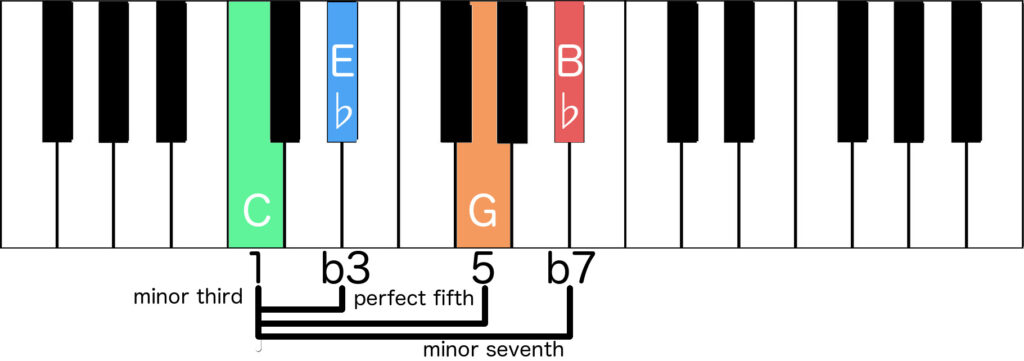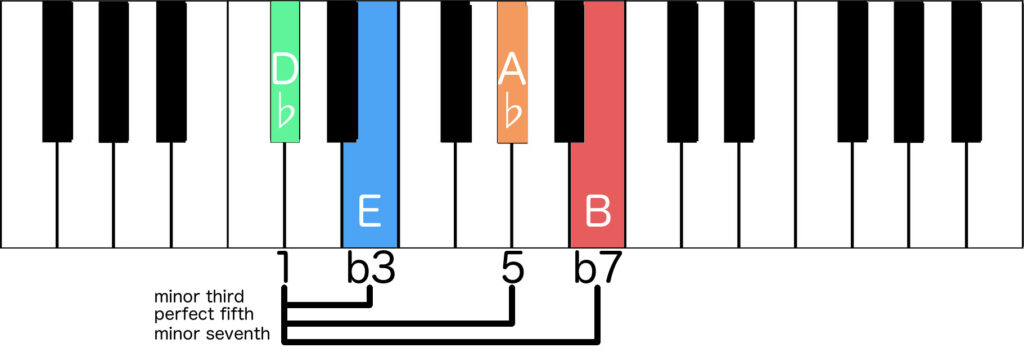Chord formulas can help you not only to play chords in any key, but they can also help you to understand chords on a different level.
We can create formulas in a few ways: the diatonic formulas and the chromatic formulas.
The big difference between those is:
- With diatonic formulas, you will know the mode and the key in which the chord is presented. But it will require you to be intimately familiar with the scale in order to play the chord by the formula.
- With chromatic formulas, you will be able to play the correct notes of the chord even if all you have is the name of the chord. But it will not give you any information about the key or the mode it represents so you will need to look at the context of the surrounding chords to get that information.
For short term gratification, I think the chromatic formulas will be the most useful. And when combined with good knowledge of chord progressions and some practice on chord analysis, they will take you every step of the way.
This post will, therefore, focus on chromatic formulas.
For a diatonic theory and diatonic chords of the major scale, please refer to my post:
► Basic Piano Chords – Theory – Diatonic Sequence
Looking for more information on inversions and smooth transitioning between chords? Then please check out my blog post ► Chord Inversions to Transition Chords Smoothly.
Chord Formula Chart
Because I know most people are here just for the chart, I will start off with that. However, for those who don’t know how to read all of this mumbo-jumbo I do explain it further down.
Major Formulas
| Chord Type | Symbol | Formula |
|---|---|---|
| Major | M, Maj | 1-3-5 |
| Added Fourth | add4 | 1-3-4-5 |
| Sixth | 6 | 1-3-5-6 |
| Six Nine | 6/9 | 1-3-5-6-9 |
| Major 7th | Maj7 | 1-3-5-7 |
| Major Ninth | Maj9 | 1-3-5-7-9 |
| Major Eleventh | Maj11 | 1-3-5-7-(9)-11 |
| Major Thirteenth | Maj13 | 1-3-5-7-(9)-(11)-13 |
| Major seven sharp eleventh | Maj7#11 | 1-3-5-7- #11 |
| Major Flat Five | – | 1-3-b5 |
Minor Formulas
| Chord Type | Symbol | Formula |
|---|---|---|
| Minor | m | 1-b3-5 |
| Minor added fourth | madd4 | 1-b3-4-5 |
| Minor sixth | m6 | 1-b3-5-6 |
| Minor seventh | m7 | 1-b3-5-b7 |
| Minor added ninth | madd9 | 1-b3-5-9 |
| Minor six add nine | m6/9 | 1-b3-5-6-9 |
| Minor ninth | m9 | 1-b3-5-b7-9 |
| Minor eleventh | m11 | 1-b3-5-b7-(9)-11 |
| Minor thirteenth | m13 | 1-b3-5-b7-(9)-(11)-13 |
| Minor/Major seventh | m/Maj7 | 1-b3-5-7 |
| Minor/Major ninth | m/Maj9 | 1-b3-5-7-9 |
| Minor/Major eleventh | m/Maj11 | 1-b3-5-7-(9)-11 |
| Minor/Major thirteenth | m/Maj13 | 1-b3-5-7-(9)-(11)-13 |
| Minor seven flat fifth or half-diminished | m7-5 or ø | 1-b3-b5-b7 |
Dominant Formulas
| Chord Type | Symbol | Formula |
|---|---|---|
| Seventh | 7 | 1-3-5-b7 |
| Ninth | 9 | 1-3-5-b7-9 |
| Eleventh | 11 | 1-(3)-5-b7-(9)-11 |
| Thirteenth | 13 | 1-3-5-b7-(9)-(11)-13 |
| Seven sharp five | 7#5 | 1-3-#5-b7 |
| Seven flat five | 7b5 | 1-3-b5-b7 |
| Seven flat ninth | 7b9 | 1-3-5-b7-b9 |
| Seven sharp ninth | 7#9 | 1-3-5-b7-#9 |
| Nine sharp five | 9#5 | 1-3-#5-b7-9 |
| Nine flat five | 9b5 | 1-3-b5-b7-9 |
| Seven sharp five sharp nine | 7#5#9 | 1-3-#5-b7-#9 |
| Seven sharp five flat nine | 7#5b9 | 1-3-#5-b7-b9 |
| Seven flat five sharp nine | 7b5#9 | 1-3-b5-b7-#9 |
| Seven flat five flat nine | 7b5b9 | 1-3-b5-b7-b9 |
| Seven sharp eleven | 7#11 | 1-3-5-b7-#11 |
Symmetrical Formulas
| Chord Type | Symbol | Formula |
|---|---|---|
| Diminished | dim (° ) | 1-b3-b5 |
| Diminished Seventh | dim7 (°7) | 1-b3-b5-bb7 |
| Augmented | aug (+) | 1-3-#5 |
Miscellaneous Formulas
| Chord Type | Symbol | Formula |
|---|---|---|
| Fifth | 5 | 1-5 |
| Flat Fifth | -5 | 1-b5 |
| Suspended Fourth | sus4 | 1-4-5 |
| Suspended Second | sus2 | 1-2-(9)-5 |
| Sharp Eleven | #11 | 1-5-#11 |
How to Use These Chord Formulas
There are two ways you could look at these formulas:
- Using interval theory which for me is the preferred method. The formulas show the intervals that are played on top of the root note, where 1 is the root note, and all other numbers are the intervals above that root.(Don’t worry, I will clarify exactly what that means)
- Using the major scale that is built from the root note indicated by the 1. All numbers in the formula then become the scale degree of that major scale. All numbers without adjustments (flat or sharp) are then diatonic notes of that major scale, whereas all flattened or sharpened numbers are chromatic adjustments of the diatonic notes of the major scale. (Sounds complex, but I will also clarify)
I say the first one has my preference, but to be honest, both have their merits.
The first method allows for very fast deciphering of the chord that will allow you to play the clustered chord instantly.
The second method will give you the absolute note names, which means you can easily invert the chords on the fly and play the chords either clustered or spread.
Formulas Using Intervals
Using intervals is actually really easy. Which goes to show how vital interval theory is when it comes to learning music and learning an instrument.
If you want to know more about intervals in general, check out my blog post here:
► Music Theory: Intervals – How To Train Your Ears
When we use the symbols that we learned in the blog post about intervals mentioned above, things should actually become crystal clear.
Example: Minor 7 => 1 – b3 – 5 – b7
For example when we take the formula for a minor 7 chord: 1 – b3 – 5 – b7
Cm7
We can apply this to any root and I will start with the easiest one of all: Cm7

With the root (1) as C, the minor third (b3) as Eb, the perfect fifth (5) as G and the minor seventh (b7) as Bb
We now have all the notes of the Cm7 chord.
Dbm7
Another example of the same formula: Dbm7

With the root (1) as Db, the minor third (b3) as E, the perfect fifth (5) as Ab and the minor seventh (b7) as B
We now have all the notes of the Dbm7 chord.
Using Intervals Really Is That Easy
Honestly, that is all you need to know if you work with intervals. It is that easy!
It does, however, mean that you need to know your intervals inside out. Using intervals, everything becomes easier 😀 and that is the big lesson to take away from this.
Formulas Using The Major Scale and Chromatic Adjustments
This is mostly a different point of view on working out the chord formulas. It involves a paradigm shift where we look at the numeric scale degrees of a major scale and adjust those notes by applying flats or sharps.
The great shift is that you will not be thinking about the intervals, but rather about the absolute notes in a given major scale. This does have the benefit that you can place those notes anywhere on your keyboard and you will be able to use spread voicings and inversions on the fly.
At the same time, it takes a lot of practice to be able to name the notes in real-time by numeric degree.
As an example, can you tell me quickly what is the 5th note of the Ab major scale? If you can, good on you! But you can see that this is something that will require a lot of time and effort to master.
Example: Minor 7 => 1 – b3 – 5 – b7
So let’s work out this example for Ab.
Abm7
We start by working out the Ab major scale. We (should) know the Ab major scale has a key signature of 4 flats: Bb, Eb, Ab and Db.
That gives us the major scale of Ab:
| Note | Ab | Bb | C | Db | Eb | F | G |
| Degree | 1 | 2 | 3 | 4 | 5 | 6 | 7 |
Then we apply our formula on this:
| Note | Ab | Bb | C | Db | Eb | F | G |
| Degree | 1 | 2 | 3 | 4 | 5 | 6 | 7 |
| Formula | 1 | b3 | 5 | b7 | |||
| Result | Ab | Cb | Eb | Gb |
With the root (1) as Ab, the flat third degree (b3) as Cb, the fifth degree (5) as Eb and the flat seventh degree (b7) as Gb
We now have all the notes of the Abm7 chord.
Why don’t we call Cb just B? Because they are the same note in principle…
We need to use every letter in the sequence. From Ab to B is a minor third interval. The alphabetical distance from A to B is only 2 and a third interval needs an alphabetical distance of 3. Cb is, therefore, the correct name of the note.
Em7
Let’s work this out using another root; the E.
Again we start by working out the E major scale. We (should) know that E major scale has a key signature of 4 flats: F#, C#, G# and D#.
That gives us the major scale of E, and we will work out the formula and the result in one go:
| Note | E | F# | G# | A | B | C# | D# |
| Degree | 1 | 2 | 3 | 4 | 5 | 6 | 7 |
| Formula | 1 | b3 | 5 | b7 | |||
| Result | E | G | B | D |
With the root (1) as E, the flat third degree (b3) as G, the fifth degree (5) as B and the flat seventh degree (b7) as D
We now have all the notes of the Em7 chord.
So Much Harder Than Intervals
I am sure you see the computations involved are far more complex than when we use the interval method. But this method reveals different information about our chord. Instead of counting semitones to get to an interval, we directly know the absolute note name and can play it anywhere on the keyboard.
One could argue that the interval method also gets you to the point where you know the absolute notes but it would involve one extra step of first playing or visualizing the note in its position within the clustered voicing of the chord. After that, you can also place those notes anywhere on the keyboard.
Why Bother?
Well even though it may not be clear right at this moment, there are a lot of reasons why in the end this method may turn out to be a lot faster and not as hard to remember as you think.
When you practice your scales, you will also be practising fingerings that are a direct reference to the degrees of the scale. Your muscle memory will get trained and it will start doing things that even your mind can’t follow.
If you want to know how that is possible, I have written a blog on how the brain works when you practice your instrument ► franspianostudio.me
What’s Next
Chords will really blow your mind once you start incorporating degrees and modes into your arsenal! If you think you know everything there is to know at this point… Think again! 😀
My next 3 blog posts will be about:
- Diatonic modes of the major scale. That is going to be a lot of fun because those will take your improvising and soloing to the next level.
- Chord substitution which in combination with the diatonic modes will make your improvisations sound like they come from another world! To infinity and beyond!!!
- The circle of fifths, because we need to get back to basics for the beginners. I can’t leave them out in the cold for too long.
Keep your eye on the walk people! More is coming soon!!!


6 Comments
Thank you for this very informative article. Your insight on the matter is amazing. I’m a musician but with a melodical instrument. So I see those numbers only on the sheet music of others. I must say it will take a long time to gain a deeper understanding, but I find it very helpful to understand finally what those numbers mean, for guitar and piano.
I have bookmarked your site and promised myself to come back and study it for real!
This is an amazing post,
Thank you very much,
Janie
Hey Janie,
Awesome response!
On your melodic instrument, this knowledge can still be very handy for playing arpeggios, but yeah it is mostly guitar and piano that benefit from this theory.
Or any instrument that can play chords for that matter.
Thank you for the compliments!
Cheers,
Tom
Wow, what a really good article on this topic. I had a general understanding of it, but you break it down and explain it very well. Very good information to know about, I enjoyed it.
Keep putting out awesome posts!
Hey Eric,
Thanks for the great compliments! I will keep the posts coming!
Cheers,
Tom
You make this topic really easy to understand. It’s something which trips a lot of people up so thank you for laying it out so beautifully.
This was really good for me to brush up on, I always forget suspended 4th and certain other chords and have to go by trial and error so this was really helpful. I definitely go by the 1st method. I can see how the 2nd method, whilst harder initially probably makes one a much better musician- it would be lovely to not think about inversions and just be able to do it, however perhaps I am just too lazy :P. I mainly play piano for fun (it is the one area in my life I try not to get too perfectionist about) however this was such a helpful article and definitely useful for me to refer back to when I am playing chords in new pieces.
Thanks so much
Hi Natalie,
Thanks for the comment!
Glad I was able to refresh your memory and never stop playing for fun 😉
Cheers,
Tom